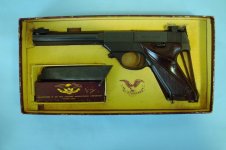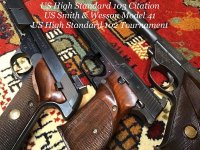It was the summer of 1962, and a young Army lieutenant was on the firing line with his Army-issued Ruger Mark I .22 pistol. The rapid-fire phase of the .22 bullseye course was finishing, and his pistol barked five times in measured cadence. Rather pleased with his performance as revealed through the spotting scope, he walked down to the targets to formally score and verify the performance of the competitor on his right. The target of the Marine captain on his right, however, was phenomenal: a nice cluster of shots in the 10-ring. The lieutenant's own performance showed a couple of shots straying into the 9 and 8 rings. When the string of shooting had finished, the young lieutenant looked at the gun the captain was putting away in his shooting box. Wow. It appeared for all the world like something out of a Buck Rogers comic strip. The barrel was long and tapered, with a beautifully streamlined recoil stabilizer on the muzzle. It had a couple of rakish weights attached to the underside of the barrel. The grip was slanted very much like the Luger pistol. The captain showed him how the wide trigger was easily adjustable for pull weight and overtravel. It had a slide lock which his issue Ruger lacked. And even more interesting, one could switch to longer, shorter or differently configured barrels with the push of a button in front of the trigger guard. The slide, when retracted, left plenty of open space for the spent shell to be ejected. There was no doubt that this pistol was seriously built for target shooting. "Go ahead, Lieutenant," the captain grinned. "You're welcome to put a few rounds down range with it if you like." A target was taped to the target frame, and the lieutenant let fly a trial rapid-fire string. One round, a called flyer, was in the 9 ring, but there was a nice group in the 10-ring, with one X. And that was my introduction to the racy Hi-Standard .22 target pistols of that era, as I was that young lieutenant. Unfortunately, a junior officer with a family could in no way afford such a delightful and relatively expensive paper-punching tool, so I carried on with the issued Ruger. Still, I lusted after that High Standard "space gun" pistol! It wasn't until many years later that I was able to find and afford one. It's illustrated here in the first picture. This is a Model 103 6 ¾"-barreled Supermatic Citation. It was made in 1963, still complete with an original box, stabilizer, tools, papers and extra magazine. It's a hard-to-find classic.


And just for comparison, here's a duplicate of the gun from my service arms room that I had to use!

The line of target pistols nicknamed the "space guns" began in late 1957 when the High Standard Manufacturing Corporation of Hamden, Connecticut started production on their Model 102 series. These were radical guns for their time, and attracted a lot of attention with their futuristic design features. No other .22 pistols were quite like them. There were four basic models. The Supermatic Trophy was the top of the line, with a high polish and gold-plated trigger. The Supermatic Citation was identical except for finish, and had plastic grips instead of the walnut grips of the Trophy. The Olympic Trophy and Citation models were chambered for the .22 short cartridge, and were designed for Olympic rapid-fire competition. There were two different configurations of the Olympic series, one designed as an out-of-the-box contender in ISU (International Shooting Union) competition. It had a unique 6 ¾" barrel with an integral rather than a detachable stabilizer. At the Pan-American games of 1959, the .22 rapid-fire champion, runner-up and the entire 4-man winning United States team all used Hi-Standard Olympic Citations. Captain Bill McMillan of the United States Marine Corps won a .22 rapid-fire Olympic gold medal in Rome with an ISU Olympic in 1960. The fourth model of the 102 series was the Tournament, a no-frills economy model without some of the advanced features of the more expensive guns. Each of these models would accept different barrels interchangeably. Barrels offered were a 10-incher with an integral rear sight over the chamber, an 8-incher with integral rear sight, and a 6 ¾-incher with no rear sight. The rear sight was mounted on the slide on this model, giving a longer sight radius than even the 10-inch barrels. Many tournament shooters accordingly preferred this length of barrel. At Camp Perry, Ohio in 1959, Hi-Standards were used in a clean sweep of the first 3 places in the .22-caliber championship. In fact, the Hi-Standard guns of this period routinely outnumbered all other makes on the line, and in most cases were more prevalent than all other makes combined! The High Standard company touted these facts in their advertisements in the gun press, and sales soared.
Here's a pic of another "space gun" I acquired about a year or so ago. It's a Citation series 102 with an 8" barrel, made in May, 1958:
As a side note, it's correct to refer to the company as "High Standard" while the guns themselves are "Hi-Standard" and are so marked on the guns.
The Model 103 versions of these models came out in late 1960. The 103s were visually identical to the Model 102s, differing only slightly in the internals. A 5 ½-inch bull barrel with a recessed muzzle was offered as an option in early 1962. This barrel was grooved on top to match the groove pattern on the top of the slide. The standard stabilizer also worked on the bull barrel, and special weights were provided for it. The bull barrel became very popular. A 7 ¼" fluted barrel also came onstream. Walnut grips became standard on the Citation 103s, replacing the plastic grips used on the Citation 102s.
The Model 104 series replaced the Model 103s in late 1963. These models reflected manufacturing changes designed to decrease production costs. The anti-backlash screw on the right side of the frame was eliminated, replaced by an Allen-head screw in the center of the trigger. Minor frame changes took place a few years later.
The Model 104s were the last of the "slant grip space guns." New "military grip" models were introduced in 1965 that mimicked the angle and feel of the Colt Model 1911 grip. These became the more popular models. The 10-inch space gun was the first to be discontinued, although it was sparingly produced through 1965. The only remaining slant grip model was the bull barrel Citation, which soldiered on until 1976. By 1966, however, the old slant grip models were almost entirely superceded by the Model 106 Military models.
Unfortunately, High Standard folded in 1984, yielding to other competitors such as Ruger and Smith and Wesson. In recent years, it has been resurrected as a new company out of Houston Texas, featuring only the military-grip models. The old slant-grip "space gun" target models are no more, and are available only on the used gun market. In their day, these pistols had no equal and were in the hands of those top competitors who recognized quality, style and performance. Even today, they will hold their own on the bullseye circuit. Prices are rapidly escalating, particularly if you find one accompanied by an original box, accessories and papers. The Hi-Standard "space guns" have become true collectibles and icons from the golden era of widespread competitive bullseye shooting. Finding one of these truly classic handguns in good shape has become a challenge today. Their owners prize them, and most aren't willing to part with them!
Thought you might enjoy these recollections and observations of an old bullseye shooter from days gone by.
John














